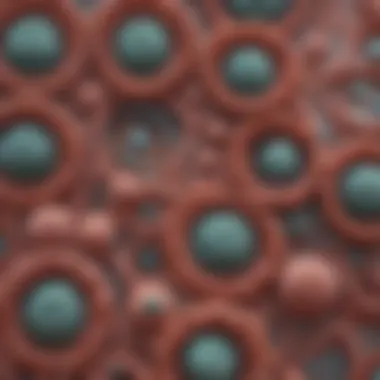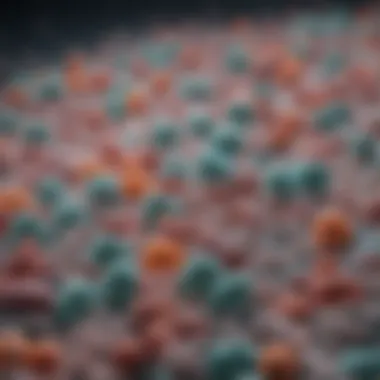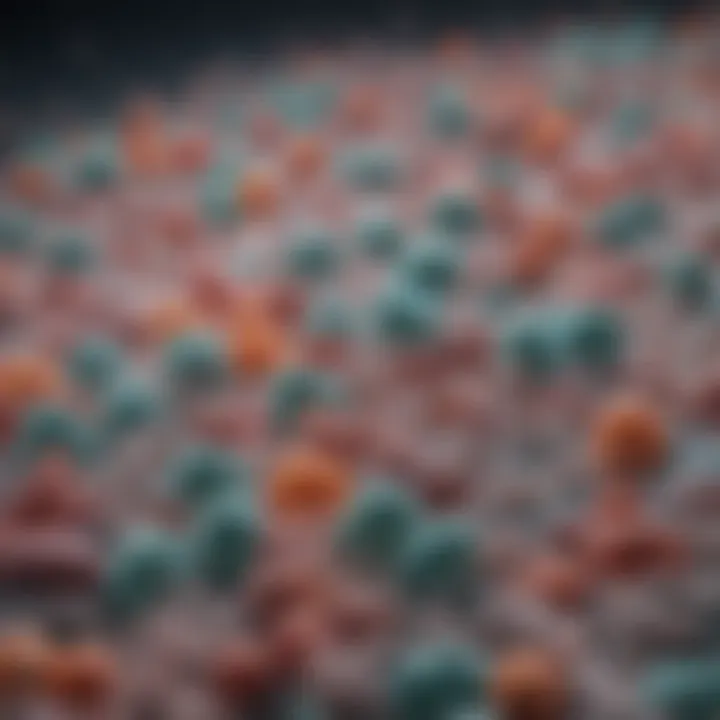Understanding Pseudomonas Aeruginosa: Insights


Intro
Pseudomonas aeruginosa is a bacterium that manifests as a formidable adversary in both health and environmental contexts. This organism is renowned for its adaptability and resilience, making it a significant pathogen, particularly in immunocompromised patients. From its diverse ecological roles to its insidious mechanisms of pathogenicity, understanding Pseudomonas aeruginosa is essential for both health practitioners and researchers.
Research Overview
Summary of Key Findings
The exploration of Pseudomonas aeruginosa reveals several key insights:
- Its ability to thrive in various environments, including soil and water, highlights its ecological versatility.
- The bacterium possesses a sophisticated arsenal of virulence factors, such as exotoxins and enzymes, aiding its survival and pathogenicity.
- Clinical challenges arise from its high levels of antibiotic resistance, primarily due to its biofilm-forming capabilities and inherent genetic traits.
Importance of the Research
Understanding Pseudomonas aeruginosa is crucial for multiple reasons. First, it occupies a unique position in both microbial ecology and clinical microbiology. As an opportunistic pathogen, it affects a wide array of patients, particularly those with underlying health conditions. Furthermore, the insight gained from studying its resistance patterns and infection strategies can inform better management and treatment protocols, enhancing patient outcomes and informing public health strategies.
Methodology
Study Design
The analysis of Pseudomonas aeruginosa involves a multi-faceted approach. Researchers assess laboratory studies alongside clinical case reviews, providing a comprehensive look at its biological and pathogenic traits.
Data Collection Techniques
Data collection methods include:
- Microbiological assays to test antibiotic sensitivities.
- Genomic sequencing techniques to identify resistance genes.
- In vitro models to study biofilm formation and virulence mechanisms.
Through a combination of in-depth review and empirical investigation, researchers can grasp the complex nature of Pseudomonas aeruginosa and its impact on human health and the environment.
Foreword to Pseudomonas Aeruginosa
Understanding Pseudomonas aeruginosa is critical, as this microorganism plays a dual role in both health and disease. It is a bacterium that presents significant challenges in clinical environments while also being an integral part of various ecosystems. The focus of this introduction is to emphasize its importance in human health, ecological balance, and its inherent versatile nature.
A significant aspect of Pseudomonas aeruginosa is its adaptability. It possesses the ability to thrive in diverse environments, ranging from soil to the human body. This adaptability highlights the complexities involved in managing infections caused by this pathogen, especially in immunocompromised individuals. Moreover, its presence in various habitats underlines its ecological significance, showcasing how it interacts with other microbial communities.
Infection control and treatment strategies are becoming increasingly relevant as healthcare environments continue to face the threat of antibiotic resistance. The rise of Pseudomonas aeruginosa as a leading cause of hospital-acquired infections necessitates a thorough examination of its characteristics and behaviors. This section sets the foundation for understanding the subsequent discussions about its taxonomy, pathogenicity, and the implications for treatment.
Overview of the Bacterium
Pseudomonas aeruginosa is a gram-negative bacterium known for its rod-like shape and distinctive color when cultivated in a laboratory. Its ability to form biofilms further increases its resilience against both the immune system and antimicrobial agents. The cell structure of this organism is complex and allows for a wide range of metabolic processes, giving it an edge in survival.
Its genome is genome-rich, containing various genes that contribute to its adaptability. This genetic composition is crucial, not only to its metabolism but also to its capacity for virulence. Pseudomonas aeruginosa can utilize different nutrients and energy sources, allowing it to colonize diverse environments. Understanding these characteristics is essential for developing effective treatment strategies and harnessing its potential benefits in bioremediation and other applications.
Historical Context
The history of Pseudomonas aeruginosa is intertwined with advancements in microbiology and medicine. First identified in the late 19th century, its significance became evident as scientists began to link it with various infections. The bacterium gained attention due to its association with high mortality rates in patients, especially those with underlying health issues.
Over time, research has revealed its complex mechanisms of pathogenicity, leading to an increased focus on treatment and management options in clinical settings. The emergence of antibiotic resistance further complicated these efforts, emphasizing the need for ongoing research and innovation in combating related infections.
To conclude, the introduction serves as a gateway to deeper insights into Pseudomonas aeruginosa's biology and the profound impact it has on health and environmental systems. The discussions that follow will further elucidate its classification, characteristics, ecological roles, and the challenges posed by this opportunistic pathogen.
Taxonomy and Classification
Taxonomy and classification are fundamental to understanding Pseudomonas aeruginosa. They provide a framework for categorizing organisms based on shared characteristics. This process allows researchers and clinicians to communicate effectively about the pathogen and its related species. With a deep understanding of its taxonomy, one can explore the diversity within the Pseudomonas genus and assess the specific traits that contribute to its pathogenicity.
Genus and Species
Pseudomonas aeruginosa belongs to the genus Pseudomonas, which is part of the family Pseudomonadaceae. This genus includes many species, yet Pseudomonas aeruginosa is the most well-known as an opportunistic pathogen.
The species name, "aeruginosa," derives from the Latin term that means "copper rust,” a reference to the green pigment it often produces. Understanding the specific classification of this bacterium helps in identifying its ecological niche, behavior, and interactions with hosts. It is essential for professionals in microbiology and medicine to recognize how this classification influences its metabolic capabilities and resistance mechanisms.
Phylogenetic Relations
The phylogenetic relations of Pseudomonas aeruginosa can reveal insights into its evolutionary history. It shares a common ancestor with other bacteria within the Pseudomonas genus, indicating a lineage that has adapted to various environments. Phylogenetic studies utilize genetic sequencing to comprehend how closely related strains may exhibit distinct pathogenic traits.
Understanding these relations is critical, especially in the context of antibiotic resistance. Certain strains may have acquired resistance genes through horizontal gene transfer, a phenomenon frequently observed within bacterial communities. By mapping its phylogeny, researchers can delineate which specific traits may confer increased virulence or survival in clinical settings.
"Taxonomy and phylogenetic analysis are necessary tools for understanding the complex interactions of Pseudomonas aeruginosa within its environment and its implications in health care settings.”
In summary, taxonomy and classification are not just academic exercises; they hold significant implications for clinical practices, research methodologies, and treatment strategies concerning Pseudomonas aeruginosa.
Morphological Characteristics
The morphological characteristics of Pseudomonas aeruginosa are fundamental to understanding its biological functions and ecological significance. This section will detail the bacterium's cell structure and metabolic flexibility, both of which contribute to its adaptability and pathogenicity.
Cell Structure
Pseudomonas aeruginosa is a gram-negative bacterium, which means it has a thin peptidoglycan layer surrounded by an outer membrane. The outer membrane is unique since it contains lipopolysaccharides, which play a crucial role in the bacterium's immune evasion. The presence of these lipopolysaccharides can trigger strong immune responses in hosts, making cell structure an essential aspect of its pathogenicity.
The cell is rod-shaped, typically measuring one to five micrometers in length. This shape aids in motility, allowing the bacterium to move effectively through its environment. Pseudomonas aeruginosa possesses polar flagella, which facilitates its movement towards nutrients while evading unfavorable conditions.
In addition to the physical attributes of its cell structure, Pseudomonas aeruginosa has various surface appendages, including pili. These structures are crucial for adhesion to surfaces and for biofilm formation. Biofilms provide a protective environment for the bacteria, enhancing survival rates in harsh environments.


Important Note: The structural features of Pseudomonas aeruginosa directly contribute to its ability to cause infections in humans. The complexity and versatility of its cell structure serve as a basis for its pathogenic mechanisms.
Metabolic Flexibility
Metabolic flexibility is a hallmark of Pseudomonas aeruginosa. This bacterium can thrive in diverse environments due to its ability to utilize a wide range of carbon sources. It is not limited to sugars, as many bacteria are; instead, it can metabolize compounds like organic acids and alcohols. This versatility allows it to colonize various ecological niches, from soil to plant roots, and even within the human body.
Pseudomonas aeruginosa is an obligate aerobe but can switch to anaerobic respiration when oxygen is scarce. This adaptability enables it to survive in environments where other organisms may not manage. Furthermore, it can form complex interactions with other microorganisms, competing for resources or benefiting from symbiotic relationships. Because of this flexibility, it can establish itself in different environments, including hospital settings, where it poses significant health risks.
Thus, the morphological traits of Pseudomonas aeruginosa, including its cell structure and metabolic abilities, play a pivotal role in its ecological success and pathogenicity. Understanding these characteristics can inform strategies to combat infections linked to this opportunistic pathogen.
Ecological Roles
Pseudomonas aeruginosa plays significant ecological roles that extend beyond its reputation as a pathogen. Understanding these roles is essential for recognizing its impact not only on human health but also on broader environmental dynamics. Its adaptability allows it to thrive in diverse environments, contributing to nutrient cycling and influencing microbial communities. In doing so, it highlights the duality of this bacterium as both a beneficial organism and a potential threat in certain contexts.
Natural Habitat
Pseudomonas aeruginosa is commonly found in various natural habitats. It inhabits soil, water, and plant surfaces, often proliferating in nutrient-rich environments. Soil samples frequently reveal its presence, where it plays a role in decomposing organic matter. Moreover, it can be isolated from freshwater sources, including rivers and lakes. This versatility in habitat preference showcases its resilience and its ability to adapt to changing environmental conditions.
In urban settings, Pseudomonas aeruginosa can be found in healthcare facilities, where its isolation from contaminated medical devices signifies its opportunistic nature. The natural habitats of this bacterium are varied, and knowledge of these locations can provide important insights into its potential transmission pathways to humans.
Role in Ecosystems
The ecological role of Pseudomonas aeruginosa extends to its interactions within ecosystems. It is involved in several biogeochemical processes, especially in the cycling of nutrients like nitrogen and carbon. By breaking down organic compounds, this bacterium contributes to soil fertility and enhances plant growth. Its metabolic capabilities allow it to utilize a wide array of substrates, which enables it to thrive and persist in ecological niches that may be inhospitable to other microorganisms.
Furthermore, Pseudomonas aeruginosa's presence in aquatic systems impacts biodiversity. It interacts with other microorganisms, often leading to complex microbial communities that can enhance ecosystem resilience. For instance, its ability to form biofilms in aquatic environments can create a habitat for other organisms, playing a significant role in maintaining ecological balance.
Pathogenicity Mechanisms
Understanding the pathogenicity mechanisms of Pseudomonas aeruginosa is crucial for grasping how this bacterium causes disease. Its ability to infect various tissues and evade the host's immune response significantly contributes to its status as an opportunistic pathogen. The mechanisms outlined in this section shed light on why Pseudomonas aeruginosa poses a considerable threat in clinical settings, particularly among immunocompromised individuals. The complexities involved are vital for developing targeted treatment strategies.
Virulence Factors
Virulence factors are specific traits that enable Pseudomonas aeruginosa to cause disease. These include various enzymes, toxins, and resistance strategies.
- Exotoxins: Pseudomonas produces proteins like exotoxin A, which inhibits protein synthesis in host cells, leading to cell death.
- Enzymes: It secretes enzymes such as elastase and proteases that degrade host tissues and facilitate invasion.
- Pigment Production: The synthesis of pigments such as pyocyanin contributes to its virulence by generating reactive oxygen species that damage host tissues.
- Capsule Formation: The capsule enhances its ability to evade phagocytosis, allowing bacteria to persist longer within the host.
Each of these factors plays an important role in the bacterium's pathogenic potential. For example, the presence of exotoxins directly correlates with increased severity of infections, making them a target for therapeutic interventions.
Invasion Strategies
Invasion strategies are the methods utilized by Pseudomonas aeruginosa to breach host defenses and establish infection. Understanding these strategies is vital for addressing the challenges posed by this pathogen.
- Adhesion: The first step in the infection process involves adhesion to host tissues. Pseudomonas has specialized adhesins that allow it to attach firmly to epithelial cells.
- Biofilm Formation: The ability to form biofilms provides a protective environment for the bacteria, making them more resistant to antibiotic treatments and immune responses. Biofilms can develop on various surfaces, including medical devices, making infections harder to treat.
- Immune Evasion: The bacterium has developed mechanisms to evade the host immune response. For instance, it can modulate immune signaling pathways and resist phagocytosis, which prolongs its survival.
- Intracellular Survival: Pseudomonas can invade host cells and survive within them, accessing nutrients and avoiding immune surveillance.
In summary, Pseudomonas aeruginosa employs a combination of virulence factors and invasion strategies that contribute to its pathogenicity. The interplay of these mechanisms underscores the need for ongoing research into targeted treatments and preventive measures. Given its adaptable nature, understanding these elements is essential to mitigate the risks it poses in healthcare settings.
Clinical Significance
The clinical significance of Pseudomonas aeruginosa cannot be overstated. This bacterium is a major opportunistic pathogen that presents considerable clinical challenges. Its ability to affect diverse patient populations and cause various infections makes understanding its implications paramount for healthcare providers. The interplay between its pathogenic traits and the host's immune response significantly influences treatment outcomes and patient care strategies.
Associated Infections
Pseudomonas aeruginosa is responsible for a wide range of infections, significantly impacting patients with compromised immune systems. Some common infection types include:
- Ventilator-associated pneumonia: This occurs in patients on mechanical ventilation, where the bacterium colonizes the respiratory tract. Its multidrug resistance complicates treatment and leads to high mortality.
- Urinary tract infections: Particularly in individuals with indwelling catheters, Pseudomonas can establish infections that are persistent and challenging to treat.
- Wound infections: This pathogen is a leading cause of infections in burn patients. The prevalence of resistant strains exacerbates the healing process and can lead to systemic infection.
- Osteomyelitis: Infections can occur post-surgery or in patients with diabetes, leading to prolonged recovery times and increased medical costs.
These infections are characterized by their recurrence and difficulty in effectively eradicating the pathogen, partly due to its ability to form biofilms that shield it from the immune response and antimicrobial agents.
Risk Factors for Infection
Several risk factors predispose individuals to Pseudomonas aeruginosa infections:
- Underlying health conditions: Conditions like cystic fibrosis, chronic obstructive pulmonary disease, and diabetes significantly increase the risk of infection.
- Immunosuppression: Patients on immunosuppressive therapy or those with weakened immune systems are at heightened risk.
- Hospitalization: Pseudomonas aeruginosa is often acquired in healthcare settings. Prolonged stays in hospitals, especially in intensive care units, increase exposure to this pathogen.
- Device usage: Catheters, ventilators, and intravenous lines provide a direct pathway for this bacterium to enter the body.
Effective infection control measures are critical to reducing these risks. They involve understanding the patient population at risk and implementing targeted prevention strategies.
"Pseudomonas aeruginosa serves as a reminder of the importance of infection control in clinical settings. Its presence complicates patient care and highlights the need for ongoing research into effective treatments."
Antibiotic Resistance
Antibiotic resistance is a critical subject when discussing Pseudomonas aeruginosa. This bacterium is notorious for its ability to resist various classes of antibiotics, which complicates treatment approaches and poses a significant threat to public health. Understanding the mechanisms that underpin its resistance not only aids in developing effective treatment strategies but also highlights the broader implications of antibiotic misuse and infection control in clinical settings. The overarching goal is to mitigate the impact of resistant strains, ensuring better health outcomes for patients who are vulnerable to infections caused by this pathogen.
Mechanisms of Resistance
Pseudomonas aeruginosa employs a range of mechanisms that contribute to its antibiotic resistance. These can be categorized into several key processes:
- Efflux Pumps: These are proteins that expel various antibiotics out of the bacterial cell, reducing their concentrations to sub-lethal levels. Pseudomonas aeruginosa has multiple efflux systems, making it difficult for antibiotics to be effective.
- Beta-lactamases: These enzymes hydrolyze the beta-lactam ring of antibiotics, such as penicillins and cephalosporins, rendering them ineffective. The presence of extended-spectrum beta-lactamases (ESBLs) and metallo-beta-lactamases adds another layer of resistance.
- Alteration of Target Sites: The bacteria can modify the targets that antibiotics bind to, such as penicillin-binding proteins. This modification can decrease the antibiotic's affinity for these targets, allowing the bacterium to survive despite treatment.
- Biofilm Formation: Pseudomonas aeruginosa is well known for forming biofilms, which are protective matrices that encase the bacterial cells. Biofilms provide a physical barrier against antibiotics and host immune responses, allowing the bacteria within to thrive in hostile environments.
By employing these mechanisms, Pseudomonas aeruginosa can not only persist in the presence of antibiotics but also complicate treatment regimens.
Impact on Treatment Options
The presence of antibiotic resistance in Pseudomonas aeruginosa has far-reaching implications for treatment options.


- Limited Choices: Many commonly used antibiotics become ineffective against resistant strains. This forces clinicians to turn to last-resort options, which can be more toxic and costly.
- Increased Treatment Duration: Infections caused by resistant Pseudomonas aeruginosa often require longer courses of treatment. This not only increases healthcare costs but also elevates the risk of prolonged hospitalization and further complications.
- Need for Combination Therapy: To overcome resistance, doctors may employ combination therapies, using multiple antibiotics simultaneously. While this can enhance treatment success, it also complicates drug interactions and potential side effects.
- Public Health Concerns: The rise of antibiotic resistance necessitates new public health strategies and policies. Effective infection control measures and antimicrobial stewardship are essential to reduce the prevalence of resistant strains in healthcare settings.
"Understanding antibiotic resistance in Pseudomonas aeruginosa is crucial for developing innovative treatments and improving patient outcomes."
The continuing evolution of resistance in Pseudomonas aeruginosa is a major concern for healthcare professionals, researchers, and patients alike. It underscores the importance of ongoing research into both the mechanisms of resistance and the development of novel therapeutic strategies that can effectively target this resilient pathogen.
Biofilm Formation
Biofilm formation is a crucial aspect of Pseudomonas aeruginosa's biology. This phenomenon involves the aggregation of bacterial cells into a self-produced matrix that adheres to surfaces. Understanding biofilms is vital for several reasons. First, biofilms provide protection to the bacteria within them from host immune responses and antimicrobial treatments. This encasement allows Pseudomonas aeruginosa to thrive in various environments, especially clinical settings where it poses significant challenges to treatment.
Another important element of biofilm formation is its impact on chronic infections. When Pseudomonas aeruginosa establishes a biofilm in a host, it can lead to persistent infections, particularly in patients with compromised immune systems or underlying conditions. The presence of biofilms complicates treatment, as they can resist higher concentrations of antibiotics compared to free-floating bacteria.
Furthermore, biofilms are not just a clinical nuance—they also play an essential role in environmental ecosystems. They help in nutrient cycling and can influence the survival of other microbes. This dual aspect of biofilm formation enhances the importance of studying Pseudomonas aeruginosa in both health and environmental contexts.
Biofilms significantly contribute to the resilience of Pseudomonas aeruginosa, making infections difficult to treat and control.
Understanding Biofilms
Biofilms are complex structures formed by bacterial cells that exhibit distinctive characteristics. In Pseudomonas aeruginosa, these biofilms can be composed of a mixture of polysaccharides, proteins, and nucleic acids, which secure the cells to each other and to surfaces. The process begins with the adhesion of cells to a surface, followed by proliferation and the production of an extracellular polymeric substance (EPS). This EPS matrix is key to biofilm integrity, allowing bacteria to survive unfavorable conditions.
Biofilms can exist on various surfaces including medical devices, lung tissues in cystic fibrosis patients, and in water treatment facilities. The development of these structures occurs in stages: initial attachment, maturation, and maintenance, and ultimately dispersal. Each stage is influenced by environmental factors and cellular communication via quorum sensing.
Clinical Implications of Biofilms
The clinical implications of biofilms formed by Pseudomonas aeruginosa are profound and troubling. In a medical context, biofilm-associated infections are often more difficult to diagnose and treat. Traditional testing methods may fail to identify biofilm-encased bacteria, leading to inadequate treatment options.
Patients with chronic conditions are at particular risk. For instance, individuals with cystic fibrosis often experience persistent lung infections caused by biofilm-forming strains of Pseudomonas aeruginosa. These infections contribute to the decline in lung function and quality of life. Moreover, biofilm formation on implanted medical devices results in device-related infections, which can complicate interventions and surgeries.
To manage these challenges effectively, health care providers must adopt strategies that target biofilm prevention and disruption. This might involve the use of combination therapies that include antibiotics and biofilm-disrupting agents, as well as regular monitoring of at-risk patients.
In summary, biofilm formation is not merely a biological curiosity; it has substantial implications for patient care and treatment strategies. Understanding the mechanisms and impacts of biofilms can guide future research and clinical approaches to mitigate the risks associated with Pseudomonas aeruginosa.
Diagnosis and Testing
In the context of Pseudomonas aeruginosa, the processes involved in diagnosis and testing are crucial. Accurate identification of this bacterium is necessary for effective treatment and management of infections. This section elaborates on laboratory techniques used in diagnosing Pseudomonas aeruginosa and emphasizes the interpretation of results in clinical settings.
Laboratory Techniques
Diagnosing infections caused by Pseudomonas aeruginosa often begins with sample collection from sites where symptoms are present. This may include respiratory secretions, urine, or wounds. Common laboratory techniques used include:
- Culture Methods: Sample is inoculated onto selective media, such as Cetrimide agar, to promote the growth of Pseudomonas aeruginosa while inhibiting other bacteria. This helps isolate the organism in clinical specimens.
- Polymerase Chain Reaction (PCR): This technique amplifies specific DNA sequences of Pseudomonas aeruginosa, allowing for rapid detection, particularly in cases where culture is negative but the clinical suspicion remains high.
- Mass Spectrometry: Techniques like MALDI-TOF (Matrix-Assisted Laser Desorption/Ionization-Time of Flight) are increasingly popular for identifying bacterial species quickly and accurately based on their protein profiles.
Each method has its own strengths and limitations, necessitating a multi-faceted approach for accurate diagnosis. Therefore, effective diagnosis often requires a combination of culture techniques and molecular methods to confirm the presence of the bacteria.
Interpretation of Results
Interpreting the results of laboratory tests involves understanding both qualitative and quantitative data. When a culture identifies Pseudomonas aeruginosa, it is essential to evaluate:
- Colony Morphology: Typical colonies show a greenish pigment due to pyocyanin production, indicating the presence of the bacterium.
- Antibiotic Sensitivity: Results from susceptibility testing indicate which antibiotics the strain is resistant or sensitive to, guiding appropriate therapeutic decisions. For instance, if a culture shows resistance to commonly used antibiotics like ciprofloxacin, clinicians must consider alternative therapies.
- Co-infections: Sometimes, Pseudomonas aeruginosa may be part of a complex community of pathogens. Therefore, knowing if co-infecting organisms are present can influence treatment choices significantly.
Accurate interpretation of test results is paramount, as delays in diagnosis can lead to severe outcomes for patients suffering from Pseudomonas aeruginosa infections.
In summary, both laboratory techniques and the interpretation of results play significant roles in the diagnosis of Pseudomonas aeruginosa infections. With advancing technology, timely and accurate diagnosis is becoming more attainable, enabling healthcare providers to tailor treatments effectively.
Treatment Options
The treatment options for Pseudomonas aeruginosa infections are critical to address the challenges posed by this opportunistic pathogen. Given its high resistance to many antibiotics, selecting effective therapeutic strategies is essential for managing infections. A multifaceted approach is often necessary to ensure treatment success.
Antibiotic Therapies
Antibiotic therapies are the most common and primary treatment method for infections caused by Pseudomonas aeruginosa. This bacterium is known for its ability to develop resistance mechanisms against a broad range of antibiotics, making it particularly difficult to treat. Common antibiotics used against Pseudomonas infections include
- Piperacillin-tazobactam
- Ceftazidime
- Cefepime
- Meropenem
- Aztreonam
The choice of antibiotic depends on the infection site, the patient’s overall health, and the specific strain's sensitivity to drugs. Sometimes, combination therapies may be necessary. For instance, combining beta-lactams with aminoglycosides can enhance the effectiveness of the treatment. However, careful monitoring is needed to avoid nephrotoxicity due to aminoglycosides.
In addition, susceptibility testing is crucial before initiating therapy. This is because the resistance patterns can vary greatly among different isolates of Pseudomonas aeruginosa. A tailored approach based on these tests can help clinicians select the most effective antibiotics, reducing treatment failure rates.
Alternative Approaches
While antibiotic therapies remain the standard approach, alternative methods are gaining recognition in the battle against Pseudomonas aeruginosa. These alternatives are essential especially in cases where antibiotic resistance is a significant barrier.
Some of the notable alternative approaches include:
- Phage Therapy: This method uses bacteriophages, which are viruses that specifically target and kill bacteria, to treat infections. Phage therapy has shown promise in cases where antibiotics fail, providing a targeted attack on Pseudomonas aeruginosa.
- Immunotherapy: Enhancing the host’s immune response against the pathogen is another approach. Immunomodulators may help strengthen the body’s natural defenses, making it better equipped to fight infections.
- Antiseptics and Disinfectants: Certain antiseptics can be effective against Pseudomonas aeruginosa, especially in wound care or debridement strategies.
- Cationic Peptides: These molecules can disrupt bacterial membranes, showing potential as a new class of antimicrobial agents against resistant strains.
The consideration of these alternative approaches is important, as they can offer solutions in an era of increasing antibiotic resistance. Clinicians should assess each case individually to devise the best possible treatment plan, which may involve combining conventional antibiotics with these innovative options.
The integration of alternative therapies into treatment protocols can provide additional tools against the challenges presented by Pseudomonas aeruginosa, promoting better patient outcomes.
Preventative Measures
In the context of Pseudomonas aeruginosa, preventative measures play a critical role in combating its pathogenicity and ensuring better health outcomes. This bacterium is notably resilient and can thrive in various environments, which makes it a concerning opportunistic pathogen. Therefore, implementing effective preventative strategies is paramount in both clinical and community settings.


Infection Control Practices
Effective infection control practices are essential in healthcare facilities to minimize the risk of Pseudomonas aeruginosa infections. Such practices include rigorous hand hygiene protocols, proper sterilization of medical equipment, and strict adherence to aseptic techniques during procedures.
Regular training for healthcare staff is important to ensure their understanding of these measures. Educating on the significance of wearing personal protective equipment, such as gloves and masks, further mitigates the chances of transmission. Isolation precautions are also advised for patients known to be infected with or colonized by this bacterium. This helps to prevent its spread to other vulnerable patients.
- Hand hygiene: Clean hands reduce infection risks significantly.
- Environmental cleaning: Regular disinfection of surfaces is crucial.
- Monitoring infection rates: Keeping track of infection statistics aids in adapting strategies when necessary.
Public Health Strategies
Public health strategies are vital for controlling the spread of Pseudomonas aeruginosa at a community level. Several approaches can be effective, including enhancing surveillance and reporting systems for this pathogen. These systems help identify outbreaks early, allowing for timely interventions.
Community education programs raise awareness about hygiene practices, especially in places like swimming pools and public showers, where the risk of exposure can increase.
- Water quality: Regular testing of water sources for Pseudomonas aeruginosa to ensure safety.
- Public health campaigns: Educating the populace on basic hygiene, particularly in high-risk environments, can significantly reduce infection incidence.
- Partnerships: Collaborating with local healthcare systems, schools, and community organizations can help amplify the message and reach broader audiences.
Proactive measures are crucial in preventing infections from Pseudomonas aeruginosa. Early interventions can save lives and reduce healthcare costs over time.
In summary, a strong focus on both infection control practices and public health strategies can significantly mitigate the impact of Pseudomonas aeruginosa on human health.
Research Directions
Research on Pseudomonas aeruginosa is crucial for several reasons. This bacterium poses significant challenges in both clinical and environmental contexts. Understanding its biology can lead to better management strategies and treatment options. This section delves into current trends and future perspectives in research regarding this pathogen, emphasizing its multifaceted roles and the need for continued exploration.
Current Trends in Research
Recent studies focus on the intricate mechanisms by which Pseudomonas aeruginosa exhibits its pathogenicity. One area of interest is the analysis of virulence factors that contribute to its resilience. For instance, researchers are exploring how this organism adapts to hostile environments and survives under various conditions. Investigations into its genetic makeup are revealing the networks of genes responsible for antibiotic resistance. High-throughput sequencing technologies are enabling scientists to examine the diversity of Pseudomonas populations in various settings, thus improving understanding of its role in infections.
Additionally, there is an emphasis on biofilm-associated research. As biofilms protect bacteria from antibiotics and the immune system, these studies are pivotal. Novel approaches to disrupt biofilm formation are being tested, suggesting potential avenues for therapeutic intervention. The synergy between Pseudomonas and other microorganisms is another growing focus. This includes studying how other bacteria influence Pseudomonas's behavior and vice versa, which could reveal new methods for controlling infections.
Future Perspectives
Looking ahead, there is a notable shift toward integrating technology with biological studies. The use of artificial intelligence and machine learning is becoming more prevalent in predicting outcomes of infections and responses to treatment. This technology could assist in tailoring personalized medicine approaches, enhancing treatment effectiveness.
Another perspective worth noting is the development of new antimicrobial agents. As antibiotic resistance remains a major obstacle, alternative therapeutics such as phage therapy and anti-virulence strategies are attracting attention. Studies are aiming to identify compounds that can both inhibit Pseudomonas aeruginosa and minimize resistance development.
Collaboration among researchers across disciplines will be essential to advance this field. Cross-disciplinary partnerships can yield insights into how environmental factors affect microbial behavior, leading to improved public health strategies.
In summary, ongoing research into Pseudomonas aeruginosa’s biological intricacies is vital. Its impact on health and the environment underscores the urgency for innovative approaches in treatment and prevention strategies.
Pseudomonas Aeruginosa in Environment
Pseudomonas aeruginosa is not just a pathogen of concern in clinical settings; it also plays a significant role in natural ecosystems. Understanding its environmental impact is essential for both ecological and health-related aspects. This section examines how Pseudomonas aeruginosa interacts with its environment, particularly focusing on its effects on water systems and its relationship with other microorganisms.
Impact on Water Systems
Pseudomonas aeruginosa is often found in water systems, both natural and artificial. The presence of this bacterium in water sources can indicate contamination, often associated with human activities. Its ability to thrive in diverse aquatic environments makes it a key indicator organism for water quality.
In drinking water supplies, Pseudomonas aeruginosa can proliferate in biofilms on the surfaces of pipes and treatment facilities. This proliferation raises health concerns, as it may lead to infections in susceptible populations. Its affinity for biofilm formation means that once established, it can be challenging to eliminate.
The bacterium also influences water quality more broadly. It can contribute to the degradation of organic pollutants, reflecting its metabolic flexibility. This property allows it to adapt to changing environmental conditions. While this aspect can be beneficial in bioremediation, it can simultaneously pose risks in specific contexts by interfering with other microbial communities in aquatic ecosystems.
Interaction with Other Microorganisms
Pseudomonas aeruginosa does not exist in isolation but interacts dynamically with a diverse array of microorganisms. These interactions can be mutualistic, antagonistic, or competitive. On one hand, Pseudomonas can help degrade toxic compounds via its metabolic processes, providing a benefit to surrounding microbial communities. This interaction can enhance the overall biodiversity in specific environments.
On the other hand, Pseudomonas aeruginosa can inhibit the growth of competing microorganisms through various mechanisms, such as the production of antibiotics and toxins. These actions can lead to a shift in community structure, potentially resulting in reduced microbial diversity. The implications for ecosystems can be profound, as changes in microbial dynamics can affect nutrient cycling, organic matter decomposition, and overall ecosystem health.
In summary, Pseudomonas aeruginosa plays a complex role in environmental settings, both positively impacting biodegradation processes and negatively affecting microbial biodiversity. Understanding these interactions is critical for managing water quality and ecological health.
Epilogue
The conclusion of an article on Pseudomonas aeruginosa serves to synthesize the key aspects included throughout the text. This section offers a means to reflect on the significant findings regarding the biology, pathogenicity, and resistance characteristics of this bacterium. Understanding these elements is essential not only for academic pursuit but also for practical applications in healthcare and environmental management.
Summary of Key Points
In summary, Pseudomonas aeruginosa is a unique pathogen with diverse biological traits. Infection rates and susceptibilities vary significantly due to its antibiotic resistance mechanisms and biofilm-forming capability. These factors contribute to its persistence in clinical settings and its role in chronic infections. Here are the main points from the article:
- Ecological Influence: Pseudomonas aeruginosa thrives in various environments, which allows it to interact with other microorganisms.
- Pathogenicity: It possesses numerous virulence factors that facilitate its invasion and survival in host tissues.
- Clinical Challenges: The difficulty in treating infections caused by this bacterium underscores the urgency for improved antibiotic therapies and public health strategies.
- Biofilm Formation: Its ability to form biofilms complicates treatment and is a critical factor in its pathogenicity.
Implications for Future Research
Research on Pseudomonas aeruginosa is crucial as it directly pertains to public health and environmental concerns. Future research directions could include:
- Targeted Therapies: Development of new antibiotics and therapeutic techniques that specifically disrupt biofilm formation.
- Genetic Studies: More in-depth exploration of its genetic coding for resistance mechanisms to better understand how they can be circumvented.
- Environmental Monitoring: Investigating the bacterium's ecological impact, especially in water systems, to mitigate its health risks.
Understanding these considerations can further prepare researchers and clinicians in addressing the challenges posed by Pseudomonas aeruginosa and enhancing overall treatment efficacy.
Citing Relevant Studies
Citing relevant studies is the core element that signals legitimacy in academic writing. In the context of Pseudomonas aeruginosa, it is pertinent to reference research that is both current and applicable. This could include studies published in peer-reviewed journals that focus on its virulence factors, resistance mechanisms, or ecological roles. The use of modern research also ensures that the information shared reflects the latest findings in microbiology, which can be especially dynamic.
Moreover, using citations helps in connecting various aspects of the bacterium. For instance, a study on its biofilm formation may connect directly to its patterns of antibiotic resistance and related challenges in treatment. By linking these studies through citations, readers can see the broader picture more effectively.
Resources for Further Reading
For those keen on expanding their knowledge about Pseudomonas aeruginosa, a variety of resources are available. Some recommended resources include:
- Wikipedia: A good starting point for general information and background. Access it here.
- Encyclopedia Britannica: Offers rigorously reviewed entries that can deepen your understanding of its clinical significance and environmental impact. Visit them here.
- Research Journals: Publications like "Journal of Medical Microbiology" and "Nature Reviews Microbiology" frequently publish empirical studies and reviews on Pseudomonas aeruginosa and related topics.
- Reddit: For community discussions and updates on research, platforms like Reddit can provide real-time insights and personal experiences related to Pseudomonas aeruginosa in various contexts. Explore further here.
- Facebook Groups: There are specialized groups focusing on microbiology and infectious diseases where professionals discuss recent findings and share valuable resources with their peers.
Accessing these resources equips readers with the necessary tools for deeper comprehension and active engagement with the material surrounding Pseudomonas aeruginosa. Their commitment to continual learning and research advancement is paramount in addressing the challenges posed by this opportunistic pathogen.



